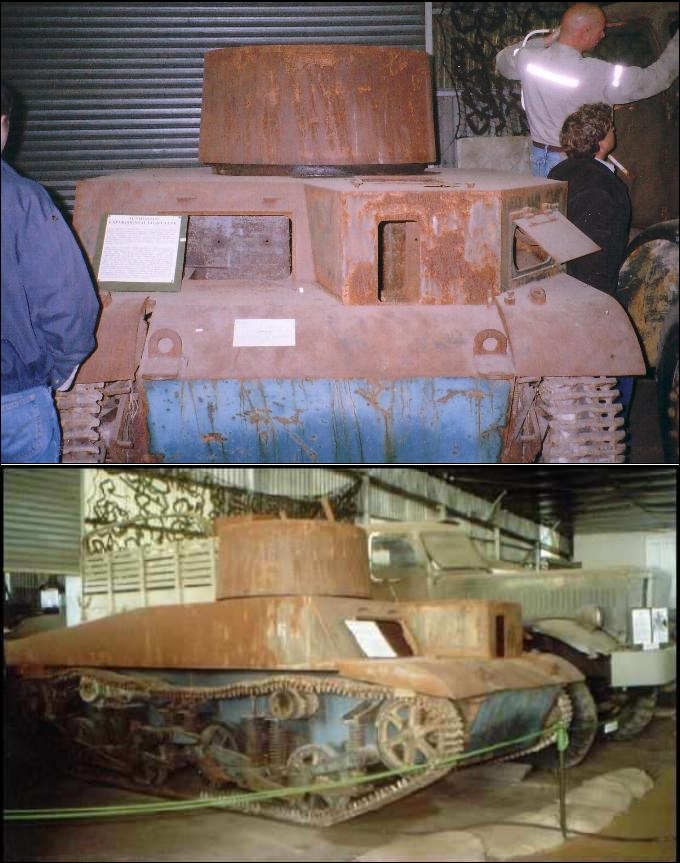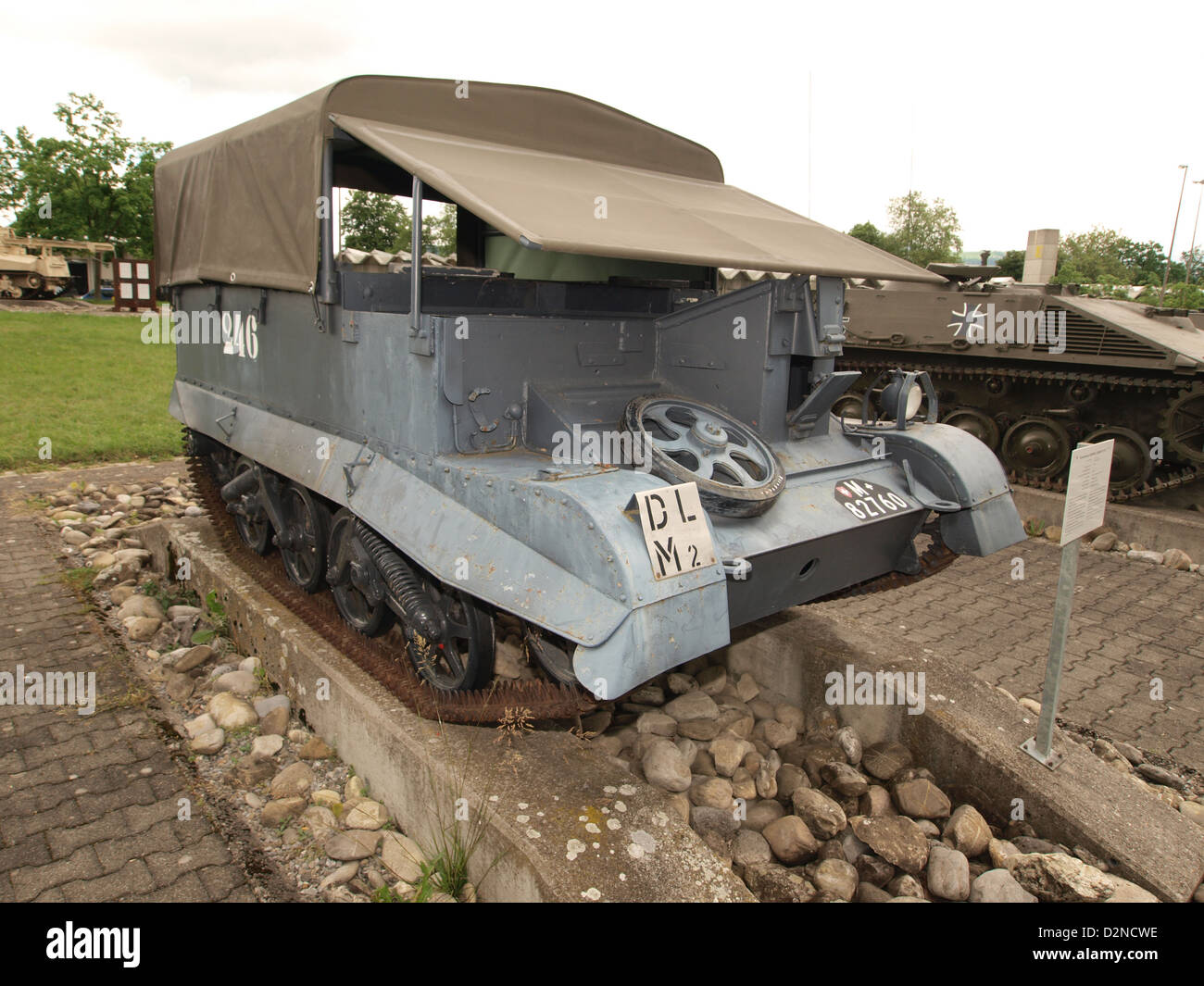
 .
.  .
. .jpg/330px-2_pdr_Aust_ATG_carrier(AWM_134672).jpg)
 .
.  .
. 


 .
. 
 .
. 
\
Variants
[edit]

Bren Carrier No.2. The earlier carriers had much less armour than the Universal. In this case only one side behind the driver protected with a sloping plate.

Universal Carrier Mk II

Flamethrower-equipped universal carrier at the Israeli Armored Corps museum in Latrun
The widespread production of the Carrier allowed for several variants to be developed, manufactured and/or used by different countries.
Argentine
[edit]
An attempted conversion to self-propelled artillery consisting of a single T16 carrier fitted with a six-Model 1968 recoilless gun mount was developed in the late 1960s or early 1970s.[citation needed]
British
[edit]
Early variants
[edit]
- Carrier, Machine-Gun No. 2
Introduced in 1937[19]
- Carrier, Bren No.2, Mark I and Mark II
Seating for three crew.[20] Armour plate on front and left hand side only.[19]
Carried a No. 11 Wireless set.[20] Armour plate on front and right hand side only.[19]
Used for carrying personnel of Light tank regiments in Mobile Divisions. A total of 50 were built by Nuffield, discontinued with the reorganization of the Mobile Divisions into Armoured divisions.[11] Seating was provided for six passengers on benches.[20]
- Carrier, Armoured Observation Post
For carrying Royal Artillery observers under protection. The machine gun position was fitted with an armoured shutter instead of gun slit. Ninety-five built in two marks.
- Carrier, Armoured, 2-pounder (40 mm)
A Carrier, Machine Gun converted to mount a 2-pdr gun with fixed armoured shield protecting the crew.
- Carrier, Armoured 6-pounder (57 mm)
A Carrier, Machine Gun converted to mount a 6-pdr gun with fixed armoured shield protecting the crew.
Later variants
[edit]
Universal Mk. I
Initial model.
Universal Mk. II
Updated stowage and layout, battery moved behind the divisional plate, towing hitch added. Welded waterproofed hull. Crew of four. 2-inch mortar or 4-inch smoke mortar beside gunner. Spare wheel on front hull. weighed 1/2 ton more than Mark I.
Universal Mk. III
Welded hull as Mark II, modified air inlet and engine cover.
Wasp (FT, Transportable, No. 2)
A flamethrower-equipped variant, using the “Flame-thrower, Transportable, No 2”. The Mark I had a fixed flamethrower on the front of the vehicle fed from two fuel tanks with a combined capacity of 100 imperial gallons (450 L). 1000 produced.[16] The Mk II had the projector in the co-driver’s position. The Mk IIC (C for Canadian) had a single 75 imperial gallons (340 L) fuel tank on the rear of the vehicle outside the armour protection, allowing a third crew member to be carried. Many Wasp variants were fitted out at No.71 Factory in Stoke-on-Trent[b]
Praying Mantis
[edit]

Praying Mantis prototype at The Tank Museum
The Praying Mantis came from an attempt to produce a low-silhouette vehicle that could still fire over obstacles. A one-man design based on Carden Loyd suspension was not adopted, but the inventor was encouraged to design a two-man version. This version was built in 1943, based on the Universal Carrier. The hull was replaced with an enclosed metal-box structure with enough room for a driver and a gunner lying prone. This box, pivoting from the rear, could be elevated. At the top end was a machine-gun turret (with two Bren guns). The intention was to drive the Mantis up to a wall or hedgerow, elevate the gun, and fire over the obstacle from a position of safety. It was rejected after trials in 1944.[21] An example of the Mantis is preserved in The Tank Museum.
Australian
[edit]

An Australian 3 inch mortar carrier
- Carrier, Machine Gun, Local Pattern, No. 1
Also known as “LP1 Carrier (Aust)”. Australian production similar to Bren carrier but welded and some minor differences.[22]
- Universal Carrier MG, Local Pattern No. 2
Also known as “LP2 Carrier (Aust)”. Australian-built variant of the Universal Carrier. Also produced in New Zealand. Used 1938–1939 Ford commercial axles; the 2A had 1940 Ford truck axles.
- 2-pounder Anti-tank Gun Carrier (Aust) or Carrier, 2-pdr Tank Attack
A heavily modified and lengthened LP2 carrier with a fully traversable QF 2 pounder (40 mm) anti-tank gun mounted on a platform at the rear and the engine moved to the front left of the vehicle. Stowage was provided for 112 rounds of 2pdr ammunition. 200 were produced and used for training.[23]
- 3 inch Mortar Carrier (Aust)
A design based on the 2 Pounder Carrier with a 3-inch (81 mm) mortar mounted in place of the 2 pounder. Designed to enable the mortar to have 360 degree traverse and to be fired either from the vehicle, or dismounted. 400 were produced and were ultimately sent as military aid to the Nationalist Chinese Army.[23]
Canadian
[edit]

Windsor carrier, Overloon Museum
“Carrier, Universal No.3”
- Mk.I* (certain differences, otherwise similar to British model)
- Mk.II* (certain differences, otherwise similar to British model)
- Mk.II*
Carrier, 2-pdr Equipped
Canadian modification of Mark I* and II* to mount 2-pdr gun. 213 used for training.[22]
Wasp Mk II*
Canadian version of the Wasp flamethrower variant.
Windsor Carrier
Canadian development with a longer chassis extended by 76 cm (30 in) and an additional wheel in the aft bogie.
American
[edit]

T16 carrier
American production of the Universal followed the same design as the British Marks I to III[19]
- Carrier, Universal No.2 Mark I - Ford GAEA engine
- Carrier, Universal No.2A Mark I - Ford GAE engine
- Carrier, Universal No.2 Mark II - Ford GAE engine
- Carrier, Universal No.2A Mark II - Ford GAEA engine
- Carrier, Universal No.2 Mark III - Ford GAE engine
- Carrier, Universal No.2A Mark III - Ford GAEA engine
T-16
The Carrier, Universal, T16, Mark I., initially “Cargo Carrier T16” was the result of US experimentation in 1942 to improve on the Universal for British use and for US in the Pacific war.[19] It was a significantly improved vehicle based upon those built by Ford of Canada, manufactured under Lend Lease by Ford in the United States from March 1943 to 1945. At 155 in (3.9 m)[24] it was longer than the Universal with an extra road wheel on the rear bogie; making for a pair of full Horstmann dual-wheel suspension units per side, the engine was a Mercury-division 239 version (GAU370) of the Ford V8 delivering the same power. Instead of the steering wheel controlling the combination brake/warp mechanism, the T-16 used track-brake steering operated by levers (two for each side). The British were supplied with over 3,200 in 1944-1945 but it was considered mechanically unreliable and had less carrying capacity than the Universal.[19] During the war, it was chiefly used by Canadian forces as an artillery tractor. After the war, was used by Argentine, Swiss (300) and Dutch forces.
German
[edit]
- 2 cm Flak 38 auf Fahrgestell Bren(e): Single barrel German 2 cm Flak 38 cannon mounted over the engine compartment of a captured Bren carrier.
- 3.7 cm Pak auf Fahrgestell Bren(e): Captured carrier of 1940, reused by the Germans and fitted with a 3.7 cm Pak 36 anti-tank gun.
- 4,7 cm Pak 35/36 L/35.6 (ö) “Böhler” auf Sfl. Bren(e): Captured Bren carrier mounting a 4,7 cm Pak 35/36 L/35.6 (ö) “Böhler” (a Cannone da 47/32 with a L/35.6 barrel, pepper box style muzzle brake and had a slightly greater performance). Created by Baukommando Becker.
- Panzerjäger Bren 731(e): Bren carriers captured by the Germans and fitted with a transport rack for three Panzerschreck anti-tank rocket launchers; the weapons were not fired from the Bren gun carrier, only transported.[25]
Italian
[edit]
In 1942, at the request of the Italian Army (Regio Esercito), Fiat produced a prototype carrier copied from a captured Universal Carrier; it was known as the Fiat 2800 or CVP-4. It is uncertain whether production vehicles were manufactured.[citation needed] Bren carriers captured by the Italians in the field were often fitted with Breda M37 machine guns.[26]  .
. 
.

 .
.  .
. .jpg/330px-2_pdr_Aust_ATG_carrier(AWM_134672).jpg)
 .
. 


 .
. 






 .
. 
 .
.